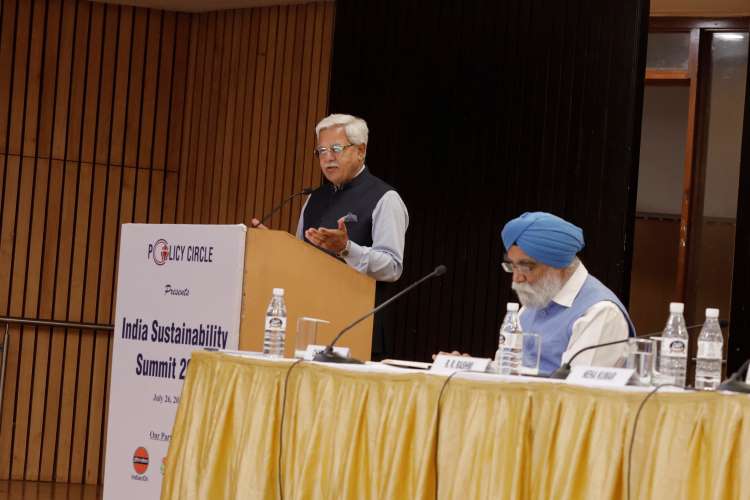
In the modern era, the topic of climate finance has emerged as a critical subject requiring urgent attention. As part of the broader discourse on green finance and financing environmental actions, climate finance has taken centre stage due to the pressing issue of climate change. This discourse involves a range of environmental actions that hold benefits for our planet, from curbing pollution and managing waste to safeguarding rivers and combating deforestation. These actions are essential for preserving our natural resources and maintaining a sustainable future, but they demand substantial financial resources. The key challenge lies in mobilising green finance to meet these environmental needs effectively.
Climate finance constitutes a specific facet of the broader green finance landscape. It addresses the unique challenges posed by climate change, which has risen to the forefront of global concerns. The urgency of the climate crisis demands a heightened focus on climate finance, as both its physical and transition risks have profound implications for societies, industries, and ecosystems.
READ I Climate finance: Charting the course for a sustainable future
Understanding climate finance
The physical risks associated with climate change are inevitable and enduring. For the next several decades, we will grapple with increased occurrences of extreme weather events, rising sea levels, floods, and deforestation. These challenges demand immediate action and substantial resources to mitigate their impact on communities and economies. On the other hand, transition risks pertain to the transformation of energy and economic systems to reduce emissions. This transition requires substantial investments in renewable energy sources and sustainable technologies, driving the need for extensive financial support.
Addressing the challenges of climate change necessitates significant financial commitments. The Department of Economic Affairs in the Government of India estimated that nearly three trillion dollars would be required by 2030 to fulfil nationally determined contributions for mitigation and adaptation. Simultaneously, the International Energy Agency projected a need for approximately four trillion dollars solely for transitioning the energy system. This staggering demand highlights the magnitude of the financial challenge at hand.
However, the resources available from governments alone are insufficient to meet these financial requirements. Current estimates place climate finance contributions at around $83 billion annually, far short of the projected trillions needed. Thus, it becomes imperative to involve a variety of stakeholders in the mobilisation of resources.
Stakeholders and strategies
Addressing the immense financial demands of climate change calls for concerted efforts from various stakeholders. Four key strategies emerge as vital components of effective resource mobilisation.
Corporate responsibility: The corporate sector holds a pivotal role in driving change. While ethical commitments and consumer awareness are valuable, they must be reinforced by a statutory framework. Corporate environmental responsibility, distinct from social responsibility, should be mandated with defined standards to ensure meaningful impact.
Capital markets: Investors play a critical role in shaping financial markets. Integrating environmental, social, and governance (ESG) criteria into investment decisions can motivate corporations to align with sustainability goals. Reducing the cost of capital for investors is essential to incentivise the shift towards environmentally friendly projects.
Financial regulation: Financial regulators, such as the Reserve Bank of India, can establish frameworks that assess risks and maintain favourable capital costs. Ensuring the cost of capital remains manageable is pivotal for driving the green momentum required for meaningful change.
Government involvement: Governments can provide the necessary regulatory support by developing a green taxonomy—a standardised framework that guides investments and activities contributing to environmental sustainability.
Embracing the transition
As we approach 2030, a critical period for climate action, focusing on transitioning our energy systems becomes paramount. Investments in renewable energy sources, such as wind, offshore, and potentially nuclear technologies, are essential to meet growing energy demands sustainably. Scaling up investments in these sectors is a significant challenge, with an estimated annual need of 20 billion dollars over the next decade to achieve established targets.
Mobilising green finance is not just an option but a necessity to tackle the complex challenges posed by climate change. The urgency of the situation demands collective efforts from governments, corporations, investors, and financial regulators.
By establishing robust frameworks, incentivising responsible investments, and driving down the cost of capital, we can begin to address the immense financial requirements needed to safeguard our planet’s future. As we move forward, a cohesive response encompassing these strategies will be crucial to achieving a sustainable and resilient global environment.
(Mr Rashmi is a distinguished fellow and programme director at TERI. He is a former member of Indian Administrative Service (1983 batch) and was principal negotiator for climate negotiations under the UNFCC.)

